高频电子技术
高频电子技术6.ppt
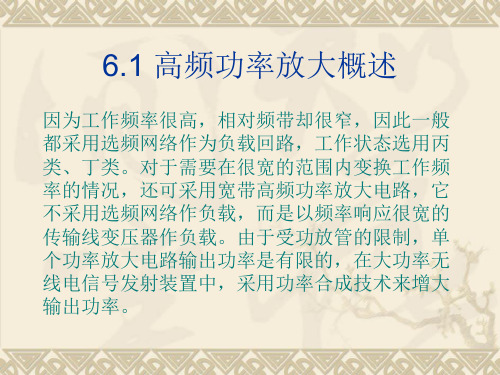
高频功放:将高频信号进行功率放大的电路,实质是在输入 高频信号的控制下,将电源的直流功率转变成高频功率。
主要功用: 放大高频信号, 以高效率输出大功率,并且尽量保 证非线性失真小。
分类:低频功放:甲类(3600导通,效率50%) 乙类(1800导通,效率78.5%) 甲乙类(大于 1800导通,效率75%)
欠压状态。电压利用率低但可变, 临界状态。 A点在临界饱和线上;
临界状态时的负载电阻 记为:ROPT。
过压状态 A点在饱和区;
Rp 斜率gd 谐振放大器的工作状态由欠压 过压 逐步过渡。
临界
U,I Ic1m Ic0
o 欠压
U cm
P,
临界 过压 Rp
o
ROPT
欠压
Pd P0
Pc 临界 过压 Rp ROPT
6.1 高频功率放大概述
因为工作频率很高,相对频带却很窄,因此一般 都采用选频网络作为负载回路,工作状态选用丙 类、丁类。对于需要在很宽的范围内变换工作频 率的情况,还可采用宽带高频功率放大电路,它 不采用选频网络作负载,而是以频率响应很宽的 传输线变压器作负载。由于受功放管的限制,单 个功率放大电路输出功率是有限的,在大功率无 线电信号发射装置中,采用功率合成技术来增大 输出功率。
结论: 随着负载的增大,电路的工作状态经历了从欠压状
态到临界状态又到过压状态的变化 ; 临界状态:效率与输出功率最佳,是谐振放大器的
最佳工作状态; 欠压状态:效率低,恒流源; 过压状态:效率高,损耗小,恒压源。
图6-12 谐振功率放大电路的测试电路
例6.1 某高频谐振功率放大电路工作于临界状态,输出 功率为15W,且UCC=24V,导通角θ=70°,ξ=0.91。试 问:
《高频电子技术(第2版)》电子教案 课程思政PPT 4.1反馈振荡器的工作原理

EXIT
高频电子线路
4.1 反馈振荡器的工作原理
(3)爱祖国的灿烂文化
• 文化传统作为一个民族群体意识的载体,常常被称为 国家和民族的“胎记”,是一个民族得以延续的“精神 基因”,是培养民族心理、民族个性、民族精神的“摇 篮”,是民族凝聚力的重要基础。人们在现实生活中, 或许会背井离乡,或许会彼此隔绝,但对祖国灿烂文化 和历史传统的认同总会把人们的心连在一起。
4.1 反馈振荡器的工作原理
振荡条件讨论与小结
振荡条件:同时满足起振条件和平衡条件
引入正反馈是构成振荡器的关键。
同时T必须具有随振荡电压Ui 增大而下降的特性
平衡点
为获得这样的
环路增益特性,反 馈环路中要有非线 性环节。
为获得正弦波,振荡电 路中要有选频环节。振荡频 率通常就由选频环节确定。
O
UiA
EXIT
高频电子线路
4.1 反馈振荡器的工作原理
4.1.3 振荡的稳定条件
干扰破坏原平衡状态后, 振荡器自动回到原平衡状态所需条件
EXIT
高频电子线路
4.1 反馈振荡器的工作原理
4.1.3 振荡的稳定条件
一、 振幅稳定条件
T
T
0
U i U i U iA
B 1
A 当反馈网络为线性网络时,
O UiB
Uf
Fu
.
.
要满足 Uf Ui
Uo 起始信号来自电扰动
.
.
起振时要满足 Uf Ui
输出信号大小满足要求
放大器 Ui Ui Au
时,要能自动稳定输出电压,
.
.
Uo
实现 Uf Ui ,使电路进入
稳定状态,输出幅度和频率
高频电子技术知识点
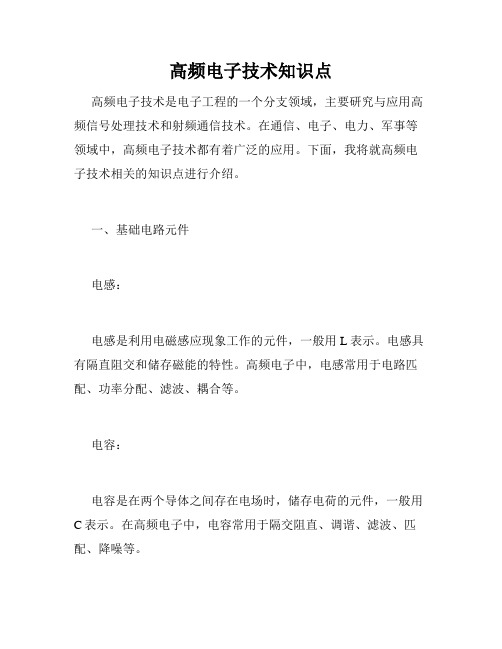
高频电子技术知识点高频电子技术是电子工程的一个分支领域,主要研究与应用高频信号处理技术和射频通信技术。
在通信、电子、电力、军事等领域中,高频电子技术都有着广泛的应用。
下面,我将就高频电子技术相关的知识点进行介绍。
一、基础电路元件电感:电感是利用电磁感应现象工作的元件,一般用L表示。
电感具有隔直阻交和储存磁能的特性。
高频电子中,电感常用于电路匹配、功率分配、滤波、耦合等。
电容:电容是在两个导体之间存在电场时,储存电荷的元件,一般用C表示。
在高频电子中,电容常用于隔交阻直、调谐、滤波、匹配、降噪等。
电阻:电阻是对电流流动的阻碍,一般用R表示。
在高频电子中,电阻常用于衰减、匹配、限流等。
二、射频器件管子:管子是射频放大中使用的一种器件,有普通三极管、场效应管、双极晶体管、集成放大器等。
管子有非常优秀的放大特性,广泛应用于射频功率放大、频率转换和混频等方面。
二极管:二极管主要用于小信号放大、检波、调制解调等。
常见的二极管有普通二极管、肖特基二极管、调制二极管、开关二极管等。
三极管:三极管在射频电路中被广泛应用,常见的三极管有高频三极管、大功率放大器三极管、全晶体三极管等。
三、射频传输线导线:导线也是射频电路中常见的元件,例如信号传输、匹配等器件组件。
导线的线径和长度会对射频信号的传输和损耗产生影响。
同轴电缆:同轴电缆是一种高频传输线路,具有很好的抗干扰性、低损耗特性和屏蔽性能。
同轴电缆具有较高的传输质量,常用于电缆电视、长距离干扰抑制等方面。
四、射频滤波器低通滤波器:低通滤波器可通过控制高频电路中的信号频率及其它参数,将高频电路中信号的高频成分滤除。
低通滤波器在通信系统中广泛应用,例如对去噪、数据整流处理等方面。
带通滤波器:带通滤波器是一种能够使某一频率范围内的信号通过的滤波器,可以通过对信号的频率范围的选择,使所需要的信号通过,而剩余的信号被滤除。
通常应用到在射频前端的所谓前置选频。
五、多路复用频分复用:频分复用是一种将多路低速信号合成成一个高速信号进行传输的技术。
《高频电子技术》单元教学设计 《高频电子技术》第三单元教学设计-吴艳红

《高频电子技术》课程单元教学设计一、课程基本情况二、学习任务描述(1) 了解丙类功率放大器的基本工作原理,掌握丙类功率放大器的调谐特性以负载变化时的动态特性。
(2) 了解激励信号变化对功率放大器工作状态的影响。
(3)比较甲类功率放大器与丙类功率放大器的功率、效率与特点。
三、单元教学目标设计1.知识目标(1)谐振功率放大器的工作原理及特性分析(2)传输线变压器及功率合成技术(3)宽带高频功率放大器(4)倍频器2.技能目标(1) 了解丙类功率放大器的基本工作原理,掌握丙类功率放大器的调谐特性以负载变化时的动态特性。
(2) 了解激励信号变化对功率放大器工作状态的影响。
(3)比较甲类功率放大器与丙类功率放大器的功率、效率与特点。
3.素质目标(1)培养学生养成自我学习的习惯和能力;(2)培养团队协作意识。
(3)培养学生理论联系实际、实事求是的优良作风和细心做事、严肃认真的科学的态度。
(4)培养标准意识、规范意识、环境保护意识。
树立良好职业道德,养成文明安全生产的习惯。
4.思政目标(1)树立正确的社会主义核心价值观,具有强烈的社会责任感;(2)树立爱岗敬业、实事求是、精益求精的精神,弘扬工匠精神;(3)具有安全意识、岗位责任意识;(4)具备开拓创新意识,能够运用基本的创新方法,有一定的创新创业创造意识和终身学习能力;(5)具有良好的团队合作能力和协调能力。
四、单元教学内容设计五、单元教学设计思路课程教学过程分为课前准备、课堂实施、课后拓展三个部分。
采用讲授法、引导法、现场教学的教学法、角色扮演法、小组讨论法,主要围绕伴音通道常见故障现象、故障分析及维修过程进行教学,课堂通过理论讲解和学生动手实训开展。
课堂设置师生互动环节,并且将课堂内容进一步细化成小节,让学生进行课堂评价,以此掌握学生课堂学习情况,老师根据学生的课堂评价情况制定下节课的课程复习内容。
六、单元教学策略设计(一)教学模式设计行动导向-工学结合、教学做一体化,采用项目教学、现场教学、以学生为中心学习开展教学工作。
高频电子技术在飞机上的应用

无线电通信面板(RCP)提供选择的频率信息和控制信号调谐 HF收发机并进行无线电选择。用RCP可选择调幅(AM)或上边 带(USB)操作。用RF灵敏度控制可增强HF接收。RCP可选择和 控制任何HF通信无线电的频率。 HF收发机发射和接收信息。收发机的发射电路用飞行内话音频调 制RF载波信号,声音信息送给其他飞机或地面台。接收电路解调 接收的RF载波分离出音频,接收的音频被机组或其它飞机系统使 用。 HF天线耦合器使天线阻抗与收发机的HF频率范围的输出相匹配。 发射期间,天线耦合器从收发机接收已被调制的RF并传给天线。 接收期间,天线耦合器从天线接收已被调制的RF并送给收发机。 HF天线发射和接收音频调制的RF信号。 外部接口
无线电通信面板的实物图
接收机的模拟图
收发机在飞机上的位置
HF天线耦合器使收发机的50Ω输出阻抗与天线阻抗在所设频率上匹配。 这使电压驻波比减少到低于1.3:1
HF天线从天线耦合器接收RF信号并向其它
飞机和地面HF通信系统发射RF信号。天线 也接收进来RF信号并把RF信号发送给天线 耦合器。
无线电通信面板 - HF收发机 - HF天线耦合器 - HF天线
控制面板向收发机发送所选频率的信息和控制信号。音频控制板 向REU发送这些信号: HF收发机接收空/地离散信号。HF收发机用这个离散信号为内部 故障存储器计算飞行段。 发射期间,话筒音频和PTT信号经REU进入HF收发机。收发机用话 筒音频调制由收发机产生的RF载波信号。收发机将调制的RF信号 经天线耦合器送到天线发射给其它飞机或地面站。 也是在发射期间,飞行数据采集组件从收发机接收PTT信号。 DFDAU用PTT作为键控信号记录发射事件。 接收期间,天线接收调制的RF信号并经天线耦合器送给收发机。 收发机从RF载波中解调或分离出音频。接受到的音频从HF收发机 经REU送到飞行内话扬声器和耳机。 选择呼叫译码器从HF收发机接收音频。SELCAL译码器监视来自 地面站的SELCAL呼叫音频。
《高频电子技术》课件

THANKS
谢谢
在此添加您的文本16字
带阻滤波器允许除某一频段外的信号通过,抑制该频段信 号。
滤波器的性能指标
通带和阻带性能
插入损耗
通带和阻带的边缘频率、带宽等参数决定 了滤波器的频率选择性和抑制能力。
滤波器对有用信号的衰减程度,以dB为单 位表示。
群时延
稳定性
滤波器对信号相位变化的量度,反映信号 通过滤波器的速度。
振荡原理
高频电子电路中的元件通 过正反馈和负反馈等机制 ,产生振荡信号,实现信 号的调制和解调等功能。
传输线原理
高频电子电路中的信号传 输遵循传输线理论,信号 在传输过程中会受到线路 的分布参数影响。
03
CHAPTER
高频电子技术中的放大器
放大器的分类与特点
分类
按功能可以分为电压放大器、功率放 大器、跨导放大器等;按频率可分为 低频放大器、高频放大器、微波放大 器等。
特点
高频放大器具有较高的增益和带宽, 能够放大微弱的高频信号;低频放大 器具有较低的噪声系数和较好的线性 度,适用于放大低频信号。
放大器的性能指标
增益
放大器的输出信号幅度与输入信号幅 度之比,反映了放大器的放大能力。
带宽
放大器能够正常工作的频率范围,反 映了放大器的频率响应能力。
线性度
放大器在小信号和大信号输入下的性 能差异,反映了放大器的失真程度。
频率范围
高频电子电路的工作频率范围,通常指几百 千赫兹到几百兆赫兹。
带宽
高频电子电路的频率响应范围,通常指电路 能够正常工作的频率范围。
增益
高频电子电路的放大倍数,用于衡量电路的 放大能力。
噪声系数
高频电子电路的噪声与信号比值,用于衡量 电路的噪声性能。
《高频电子技术(第2版)》电子教案 课程思政PPT 4.3 振荡器的频率和振幅稳定度

4.3 振荡器的频率和振幅稳定度
三、提高频率稳定度的主要措施
1. 减小外界因素变化的影响
将决定振荡频率的主要元件或整个振荡器置于恒温槽 采用高稳定度直流稳压电源 采用金属屏蔽罩
采用减震器 采用密封工艺减小大气压力和湿度的影响
在振荡器和负载之间加缓冲器
EXIT
高频电子线路
4.3 振荡器的频率和振幅稳定度
主要由于器件老化。
短期频率稳定度 一天之内振荡频率的相对变化量 主要由于温度、电源电压等外界因素变化
瞬时频率稳定度 秒或毫秒内振荡频率的相对变化量
由电路内部噪声或突发性干扰引起。
EXIT
高频电子线路
4.3 振荡器的频率和振幅稳定度
4.3.1 频率稳定度
一、频率稳定度的概念
中波广播电台发射机的频率稳定度为 105
三、提高频率稳定度的主要措施
1. 减小外界因素变化的影响 2. 提高谐振回路的标准性
谐振回路在外界因素变化时,保持其谐振频率不变 的能力,称为谐振回路的标准性。
回路标准性越高,频率稳定度越好。
EXIT
高频电子线路
4.3 振荡器的频率和振幅稳定度
三、提高频率稳定度的主要措施
1. 减小外界因素变化的影响
EXIT
高频电子线路
4.3 振荡器的频率和振幅稳定度
二、导致频率不稳定的因素
外因: 温度、电源电压和负载等外界因素的影响
主要利用谐振回路的相频特性实现。振荡频率 处相频特性曲线越陡,稳频效果越好。
内因: 振荡电路的稳频能力 1. 提高回路Q值;2. 使振荡频率接近回路谐振频率。
EXIT
高频电子线路
高频电子线路
4.3 振荡器的频率和振幅稳定度
高频电子技术王卫东第三版 课后题答案

部电路是一个线性化双平衡 Gilbert 相乘器电路.
第五章。。。。。。。。。。。。。。。。。。。。。。。。。。。。。。。。。。。。
(1)高频信号的某一参数随消息信号的规律发生变化
的过程称为调制,其逆过程称为解调.其中消息信号
称为调制信号,高频信号称为载波信号.调制后的信
号称为已调波信号.
(2)按照调制信号的形成可将调制分为模拟调制和数
振回路好.
(9)高频小信号放大器采用谐振回路作负载,因此,该
放大器不仅有放大作用,而且也具有滤波或选频的作
用.而且由于输入信号较弱,因此放大器中的晶体管
可视为线性元件.高频电子电路中常采用 Y 参数等效
电路进行分析.衡量高频小信号放大器选择性两个重
要参数分别是 , .
(10)不考虑晶体管 的作用,高频小信号调谐放大器
1 按照电流导通角θ来分类,θ=180°的高频功率放
大器称为甲类功放,θ>90°的高频功率放大器称为
甲乙类功放,θ=90°的高频功率放大器称为乙类功
放,θ<90°的高频功率放大器称为丙类功放.
(1)高频功率放大器一般采用谐振回路作为负载,属
丙类功率放大器.其电流导通角θ<90°.兼顾效率和
输出功率,高频功放的最佳导通角为θ=70°.高频功
个”双向元件”,从而导致电路的不稳定.为了消除
的反馈作用,常采用单向化的办法变”双向元件”
为”单向元件”.单向化的方法主要有中和法和失配
法.
(15)晶体管单向化方法中的失配法是以牺牲增益来
换取电路的稳定,常用的失配法是共发-共基.
第二章.。。。。。。。。。。。。。。。。。。。。。。。。。。。。。。。。。。。。。。
高频电子技术的y参数名词解释
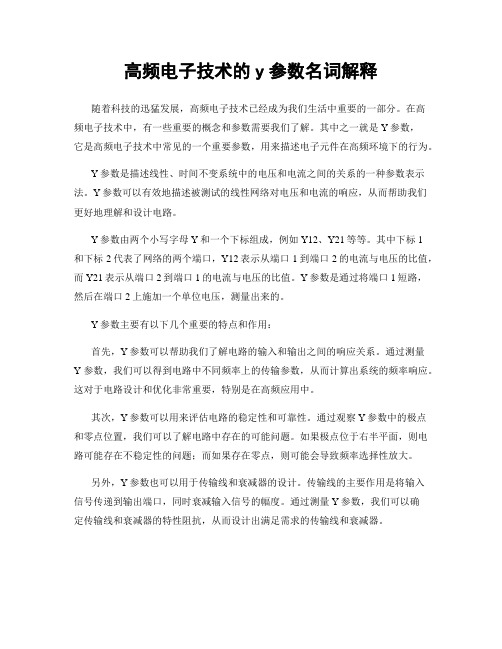
高频电子技术的y参数名词解释随着科技的迅猛发展,高频电子技术已经成为我们生活中重要的一部分。
在高频电子技术中,有一些重要的概念和参数需要我们了解。
其中之一就是Y参数,它是高频电子技术中常见的一个重要参数,用来描述电子元件在高频环境下的行为。
Y参数是描述线性、时间不变系统中的电压和电流之间的关系的一种参数表示法。
Y参数可以有效地描述被测试的线性网络对电压和电流的响应,从而帮助我们更好地理解和设计电路。
Y参数由两个小写字母Y和一个下标组成,例如Y12、Y21等等。
其中下标1和下标2代表了网络的两个端口,Y12表示从端口1到端口2的电流与电压的比值,而Y21表示从端口2到端口1的电流与电压的比值。
Y参数是通过将端口1短路,然后在端口2上施加一个单位电压,测量出来的。
Y参数主要有以下几个重要的特点和作用:首先,Y参数可以帮助我们了解电路的输入和输出之间的响应关系。
通过测量Y参数,我们可以得到电路中不同频率上的传输参数,从而计算出系统的频率响应。
这对于电路设计和优化非常重要,特别是在高频应用中。
其次,Y参数可以用来评估电路的稳定性和可靠性。
通过观察Y参数中的极点和零点位置,我们可以了解电路中存在的可能问题。
如果极点位于右半平面,则电路可能存在不稳定性的问题;而如果存在零点,则可能会导致频率选择性放大。
另外,Y参数也可以用于传输线和衰减器的设计。
传输线的主要作用是将输入信号传递到输出端口,同时衰减输入信号的幅度。
通过测量Y参数,我们可以确定传输线和衰减器的特性阻抗,从而设计出满足需求的传输线和衰减器。
除此之外,Y参数还可以用于研究和分析不同电路拓扑结构的性能。
通过比较不同电路结构的Y参数,我们可以了解它们在高频环境下的行为,从而选择合适的电路结构来满足特定的需求。
总之,Y参数是高频电子技术中重要的一个概念和参数。
它可以帮助我们了解电子元件在高频环境下的行为,评估电路的稳定性和可靠性,优化电路设计,以及研究不同电路结构的性能。
《高频电子技术》ppt课件

Yie
Ib U b
|U c 0
输出交流短路时的输入
导纳
Y fe
Ic U b
|U c 0
输出交流短路时的正向
传输导纳
Yre
Ib U c
|Ub 0
输入交流短路时的反向
传输导纳
Yoe
Ic U c
|Ub 0
输入交流短路时的输出
导纳
Y参数是任务频率的函数,当任务频率不同时,即使是 同一晶体管,其Y参数也是不一样的。当任务频率比较 低,电容效应的影响可以不思索时,晶体管的Y参数才 可以以为近似不变。假设忽略Y参数的虚部,那么可得到 低频任务的Y参数值。
常用途理方法: 1 、中和法: 晶体管B、C 极之间参与一个电容 2、失配法:使晶体管的负载阻抗与输出阻抗不匹配
图3-9 中和法原理电路
失配法:
图3-10 共射-共基级联放大器交流等效电路
3.4 集中电路高频小信号放大器 由线性集成电路与选频电路相结合方式实现 又称模拟集成电路
3.4.1 线性宽频带集成放大电路 8FZ1 ULN2204
rbb`: 基区体电阻25Ω; rb`e:发射结电阻150Ω; Cb`e: 发射结电容500pF;
Cb`c: 集电结电容5pF ; rb`c:集电结电阻1MΩ ;(反偏, 很大,被Cb`c短接掉)
rce: 集-射极电阻100kΩ; Cce:集电极电容; (很大,被 rce短接掉)
gm: 晶体管跨导,反映放大才干; gm=IEQ/26=β0/rb`e 50ms
噪声 普通指内部噪声,又分自然和人为两类。自 然噪声有热噪声、散粒噪声和闪烁噪声等,人为噪声有 交流噪声、感应噪声等。
干扰 普通指外部干扰,也分自然和人为两类。自 然干扰有天电干扰、宇宙干扰和大地干扰等。人为干扰 有工业干扰和无线电台干扰。
《高频电子技术(第2版)》电子教案 课程思政PPT 6.1调角信号基本特性
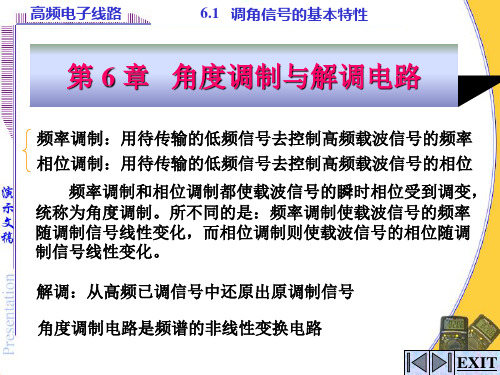
0
EXIT
高频电子线路
6.1 调角信号的基本特性
m mP
EXIT
高频电子线路
6.1 调角信号的基本特性
[例] 已知 u(t) = 5 cos (2 103 t)V , 调角信号表达式为
uo(t) =10 cos [ (2 106 t ) +10cos (2 103 t)]V 试判断该调角信号是调频信号还是调相信号,并求调制 指数、最大频偏、载波频率和载波振幅。
dt
当 = c 时: (t ) ct 0
EXIT
高频电子线路
6.1 调角信号的基本特性
6.1.2 调频信号与调相信号
一、调频信号
载波信号: uc (t ) Um cos(ct 0 )
调制信号: u (t )
rad / s·V 角频偏
调频波瞬时角频率:(t) = c+ kf u(t) = c +
0 t
(d)
图6.1.3 调相信号波形 (a)调制信号 (b)附加相位变化 (c)瞬时角频率变化 (d)调相信号
EXIT
高频电子线路
6.1 调角信号的基本特性
三、调频信号与调相信号的比较
载波信号 uc(t) = Um cos c t 调制信号u(t) = U m cos t
调频
调相
瞬时角频率
(t)
高频电子线路
6.1 调角信号的基本特性
第 6 章 角度调制与解调电路
频率调制:用待传输的低频信号去控制高频载波信号的频率 相位调制:用待传输的低频信号去控制高频载波信号的相位
频率调制和相位调制都使载波信号的瞬时相位受到调变, 统称为角度调制。所不同的是:频率调制使载波信号的频率 随调制信号线性变化,而相位调制则使载波信号的相位随调 制信号线性变化。
《高频电子技术(第2版)》电子教案 课程思政PPT 第 1 章 绪 论

通信与通信系统 无线电波段的划分与无线电波的传播 非线性电子线路的基本概念 思政目标:中国精神是兴国强国之魂 本章小结
1.1通信与通信系统
主要要求:
掌握通信系统的基本组成及各组成部分的作用 了解调幅广播通信系统的基本组成及各组成部 分的作用 了解数字通信系统的基本组成及各组成部分的 作用 理解通信系统中为何要采用调制技术
数字调制:用数字基带信号对高频正弦波进行的调制
用数字基带信号去控制高频信号的振幅,称为振幅键控 ASK 频率,称为频率键控 FSK 相位,称为相位键控 PSK
数字通信系统抗干扰、抗噪声能力强,易利用计算机进 行处理。
六、通信系统的基本单元电路
高频小信号放大电路、高频功率放大电路、振荡电路、
调制电路、解调电路、混频器、倍频器、低频放大电路
模拟通信系统 数字通信系统 广播通信系统 电视通信系统
接收者 如电话 接收者 如广播、电视 接收者 如对讲
一、重精神是中华民族的优秀传统
道德理想,也称人格理想,指人们在做人方面所向往和追求 的目标。道德与信念密切相关,它是靠内在的信念和社会舆 论来维系的,人的良心就是一种道德信念的形式。一个人认 为自己应具有什么样的道德品质,形成什么样的人格形象, 学习什么样的理想人格,这是人们在道德修养方面的理想追 求。追求高尚的理想人格,使自己富有人格的魅力,成为一 个为社会所需要、为他人所喜欢的人,既是事业成功的关键, 又是生活幸福的根本。
一、通信系统的基本组成
通信: 发送者与接收者之间的信息传递 通信系统:利用电信号或光信号实现信息传递的系统
信源
已调信号
调制 (高频信号) 解调
输入 发送 变换器 设备
信道
接收 设备
高频电子技术的研究与应用
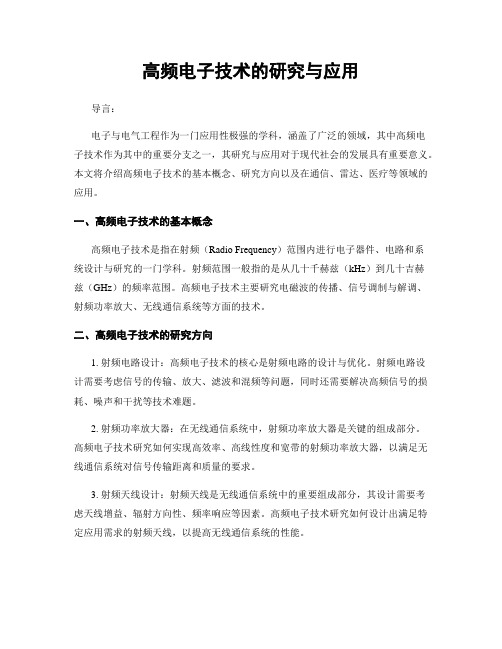
高频电子技术的研究与应用导言:电子与电气工程作为一门应用性极强的学科,涵盖了广泛的领域,其中高频电子技术作为其中的重要分支之一,其研究与应用对于现代社会的发展具有重要意义。
本文将介绍高频电子技术的基本概念、研究方向以及在通信、雷达、医疗等领域的应用。
一、高频电子技术的基本概念高频电子技术是指在射频(Radio Frequency)范围内进行电子器件、电路和系统设计与研究的一门学科。
射频范围一般指的是从几十千赫兹(kHz)到几十吉赫兹(GHz)的频率范围。
高频电子技术主要研究电磁波的传播、信号调制与解调、射频功率放大、无线通信系统等方面的技术。
二、高频电子技术的研究方向1. 射频电路设计:高频电子技术的核心是射频电路的设计与优化。
射频电路设计需要考虑信号的传输、放大、滤波和混频等问题,同时还需要解决高频信号的损耗、噪声和干扰等技术难题。
2. 射频功率放大器:在无线通信系统中,射频功率放大器是关键的组成部分。
高频电子技术研究如何实现高效率、高线性度和宽带的射频功率放大器,以满足无线通信系统对信号传输距离和质量的要求。
3. 射频天线设计:射频天线是无线通信系统中的重要组成部分,其设计需要考虑天线增益、辐射方向性、频率响应等因素。
高频电子技术研究如何设计出满足特定应用需求的射频天线,以提高无线通信系统的性能。
4. 射频集成电路设计:随着微电子技术的发展,射频集成电路(RFIC)的研究与应用越来越重要。
高频电子技术研究如何在集成电路中实现射频信号的处理、放大和调制等功能,以提高系统的集成度和性能。
三、高频电子技术在通信领域的应用1. 无线通信系统:高频电子技术在无线通信系统中发挥着重要作用。
通过射频电路的设计和优化,可以实现高速、稳定的无线数据传输,满足现代社会对通信的需求。
2. 卫星通信:高频电子技术在卫星通信系统中的应用也非常广泛。
通过射频功率放大器、射频天线和射频集成电路等技术手段,可以实现卫星通信系统的高效率、高可靠性和广覆盖性。
《高频电子技术及应用》课程标准

《高频电子技术及应用》课程标准一、课程基本信息二、课程概述(一)课程定位本课程是应用电子技术、电子信息工程技术、通信工程技术专业的一门重要的、核心的、必修的技术基础课。
本课程的主要内容是以非线性电路为主,是在学习了“电路分析与应用”和“模拟电子技术及应用”的基础上,进一步学习掌握各种高频电子线路模型、电路工作原理和性能、电路的分析方法的内在联系,以期达到能运用各种高频电路的能力。
同时也为专业课与其它电子信息学科的学习打下必要基础,培养学生分析问题、解决问题的能力。
本课程是为学习应用电子技术、电子信息技术等专业开设的一门专业基础必修课程,这是为了适应21世纪高等职业教育和高等专科教育的发展,培养更多适合现代社会的应用型人才,以及当前集成电路技术发展而开设的。
随着通信技术日新月异的发展,通信集成电路的工作频率通常很高,这就要求应用电子技术、电子信息技术等专业的学生具备高频电路的基础知识。
通过本课程的学习,可以使学生系统、完整地掌握高频电子技术的基本概念和基本理论,掌握非线性电子线路的基本分析方法,具有一定分析和解决具体问题的能力。
(二)课程基本理念根据情况在下列中落实课程理念:坚持以服务为宗旨,以促进就业为导向的专业建设方针;坚持“校企合作”共建专业的办学模式;坚持“工学结合”的高职人才培养模式;坚持“以学为本”的教育理念和“以学生为主体”的教学理念;坚持职业能力培养为主线,加强实践能力培养;加强素质教育,强化职业道德。
(三)课程设计思路课程设置的指导思想是按照理实一体化教学情境设置,把整个课程理论、实验和实训进行融合,课程的设计突出“素质”、“知识”与“能力”三个特点。
本课程为项目为单元组织教学,通过具体案例,将高频无线通信实施的顺序逐步展开,其应用贯穿课程整个内容,让学生在用什么、学什么、会什么的过程中,逐步掌握专业技能和相关专业知识,培养学生的实际操作能力。
本课程在理论授课中,采用多媒体教学课件,利用视频动画来激发学生们学习兴趣,既创造生动活泼教学氛围,又解决了课时少内容多的矛盾。
高频电子技术(安徽财经大学)智慧树知到答案章节测试2023年
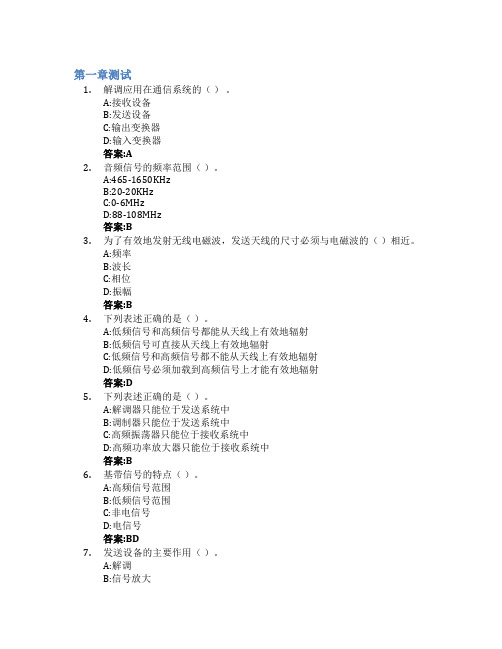
第一章测试1.解调应用在通信系统的()。
A:接收设备B:发送设备C:输出变换器D:输入变换器答案:A2.音频信号的频率范围()。
A:465-1650KHzB:20-20KHzC:0-6MHzD:88-108MHz答案:B3.为了有效地发射无线电磁波,发送天线的尺寸必须与电磁波的()相近。
A:频率B:波长C:相位D:振幅答案:B4.下列表述正确的是()。
A:低频信号和高频信号都能从天线上有效地辐射B:低频信号可直接从天线上有效地辐射C:低频信号和高频信号都不能从天线上有效地辐射D:低频信号必须加载到高频信号上才能有效地辐射答案:D5.下列表述正确的是()。
A:解调器只能位于发送系统中B:调制器只能位于发送系统中C:高频振荡器只能位于接收系统中D:高频功率放大器只能位于接收系统中答案:B6.基带信号的特点()。
A:高频信号范围B:低频信号范围C:非电信号D:电信号答案:BD7.发送设备的主要作用()。
A:解调B:信号放大D:调制答案:BD8.接收设备的主要作用()。
A:选频滤波B:信号放大C:调制D:解调答案:ABD9.按基带信号的不同,通信系统可分为模拟通信系统和数字通信系统。
()A:错B:对答案:B10.直接放大式接收机对不同的电台接收效果不同,调谐比较复杂。
()A:错B:对答案:B第二章测试1.LC串联谐振电路谐振时,回路的阻抗为()。
A:零B:电容性C:最小且为纯阻性D:最大且为纯阻性答案:C2.LC串联谐振电路谐振时,回路两端()最大。
A:电容B:电压C:电流D:电阻答案:C3.LC并联谐振电路谐振时,回路的阻抗为()。
A:最小且为纯阻性B:电感性C:最大且为纯阻性D:零答案:C4.LC并联谐电路路谐振时,回路两端()最大。
A:电压B:电流C:电阻答案:A5.并联谐振电路接入负载后,品质因数会()。
A:减小B:零C:不变D:增大答案:A6.LC串联谐振电路失谐时阻抗减小。
()A:错B:对答案:A7.LC并联谐振电路失谐时阻抗增大。
《高频电子技术》课程标准
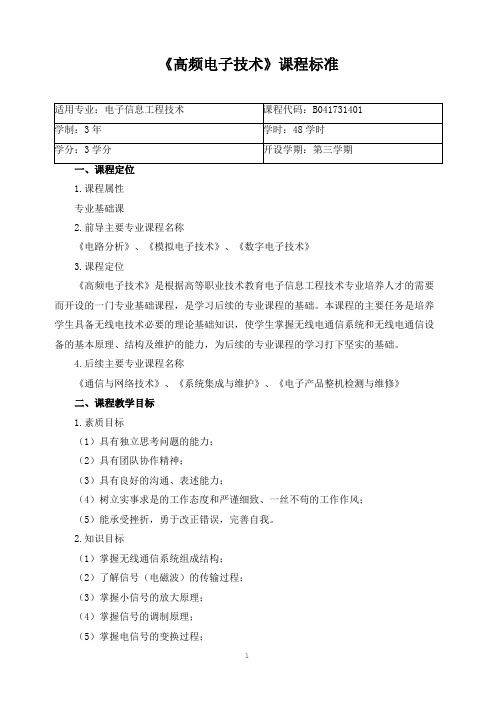
《高频电子技术》课程标准1.课程属性专业基础课2.前导主要专业课程名称《电路分析》、《模拟电子技术》、《数字电子技术》3.课程定位《高频电子技术》是根据高等职业技术教育电子信息工程技术专业培养人才的需要而开设的一门专业基础课程,是学习后续的专业课程的基础。
本课程的主要任务是培养学生具备无线电技术必要的理论基础知识,使学生掌握无线电通信系统和无线电通信设备的基本原理、结构及维护的能力,为后续的专业课程的学习打下坚实的基础。
4.后续主要专业课程名称《通信与网络技术》、《系统集成与维护》、《电子产品整机检测与维修》二、课程教学目标1.素质目标(1)具有独立思考问题的能力;(2)具有团队协作精神;(3)具有良好的沟通、表述能力;(4)树立实事求是的工作态度和严谨细致、一丝不苟的工作作风;(5)能承受挫折,勇于改正错误,完善自我。
2.知识目标(1)掌握无线通信系统组成结构;(2)了解信号(电磁波)的传输过程;(3)掌握小信号的放大原理;(4)掌握信号的调制原理;(5)掌握电信号的变换过程;(5)掌握小信号的解调过程;(6)了解反馈控制电路原理;3.能力目标(1)能够分析基本单元电路;(2)具有设计基本电路单元的能力;(3)具有焊接、调试、组装电路的能力;(4)学会分析各种单元高频电路、模拟集成电路、系统电子线路的能力;(5)能解决通信电子线路中各种实际问题;(6)具有理论联系实际能力和实际操作的能力。
三、课程教学内容及学时建议见表1。
表1《高频电子技术》课程主要教学内容及要求1.校内教师标准(1)具有高校教师资格和本专业领域有关证书;(2)有理想信念、有道德情操、有扎实学识、有仁爱之心;(3)具有电子类相关专业本科及以上学历;(4)具有扎实的电子类专业相关理论功底和实践能力;(5)具有较强信息化教学能力,能够开展课程教学改革和科学研究;(6)每5年累计不少于6个月的企业实践经历。
3.教材选用标准(1)按照国家规定选用优质教材、高职高专规划教材、禁止不合格的教材进入课堂;(2)教学实施单位应建立由专业教师、行业专家和教研人员等参与的教材选用机构,严格教材选用,经过规范程序择优选用教材。
高频电子技术课程设计

高频电子技术课程设计1.背景高频电子技术是电子科学与技术的重要分支之一,它在通信、雷达、卫星导航、医学诊断、军事等领域有着广泛的应用。
经过多年的积累和发展,高频电子技术已经成为学科体系比较完备的学科之一,学生在掌握基础理论的基础上需要通过课程设计加强实践能力。
2.课程设计目标本次课程设计旨在培养学生运用高频电子技术进行电路设计、仿真及优化的能力,同时锻炼学生的团队合作能力和科技创新意识。
具体要求如下:1.利用软件对高频电子系统进行建模、仿真和分析,达到对系统性能进行评估、优化和设计的目的。
2.设计高频电路,包括但不限于微波功率放大器、微带滤波器、变频器、混频器等。
3.将高频电路实现在PCB板上,并进行测试和优化。
3.课程设计内容第一部分:仿真分析在第一部分的课程设计中,学生需要掌握使用仿真软件进行高频电路系统的建模、仿真和分析的方法。
具体要求如下:1.利用ADS等仿真软件对高频电路进行建模,并进行仿真分析。
2.分析电路的主要频率响应特性、噪声等级、带宽等参数。
3.通过仿真实验获取电路的主要性能参数,并进行分析和比较。
4.展示仿真实验结果,进行讨论并总结结论。
第二部分:电路设计在第二部分的课程设计中,学生需要掌握高频电路的设计方法和技巧,设计多种高频电路,并优化其性能。
具体要求如下:1.设计微波功率放大器、微带滤波器、变频器、混频器等高频电路。
2.选取适当的元器件、器件参数以及电路拓扑结构,以满足电路设计要求。
3.搭建电路原型,进行实验,并优化其性能。
4.讨论电路参数与性能的关系,并总结设计方法和技巧。
第三部分:电路实现和测试在第三部分的课程设计中,学生需要掌握PCB布局与设计的方法,以及测试和校准高频电路的方法。
具体要求如下:1.使用Altium Designer等软件完成PCB电路设计和布局。
2.进行PCB板加工、组装和调试。
3.掌握测试高频电路的方法和技巧,包括有源器件的测试、无源器件的测试以及系统的测试。
《高频电子技术(第2版)》电子教案 课程思政PPT 4.5 RC振荡
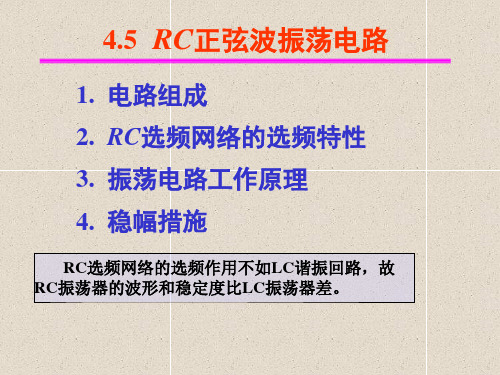
f
0
(+) (+) (+)
用瞬时极性法判断可知,电
路满足相位平衡条件
a f 2n
此时若放大电路的电压增益为
AV
1
Rf R1
3
Av
则振荡电路满足振幅平衡条件
AV FV
3 1 1 3
电路可以输出频率为
f0
1
2RC
的正弦波
RC正弦波振荡电路一般用于产生频率低于 1 MHz 的正弦波
4. 稳幅措施
采用非线性元件
Z2 Z1 Z2
sCR
1 3sCR (sCR )2
又 s j
且令
0
1 RC
则
FV
3
1
j(
0 )
0
幅频响应
FV
1
32 ( 0 )2 0
( 0 )
相频响应
f arctg
0
3
2. RC串并联选频网络的选频特性
FV
1
32 ( 0 )2 0
( 0 )
f arctg
0.1 1 10 0
–20 –40
超前
90 45
0 0.1 1 10
一阶高通
f / fL f / fL
20lg|A•u |/dB
0.1 1 10 100 0 –.1 1 10 0 –45
–90
一阶低通
f / fH
二、RC 移相式振荡电路
C C C R Rf
8
RR
U o
的封建专制统治,是近现代爱国主义的 主题。
现阶段爱国主义的主题: “同促进历史发展密切联系在一起,同维护祖国
” 独立和广大人民的根本利益联系在一起。
- 1、下载文档前请自行甄别文档内容的完整性,平台不提供额外的编辑、内容补充、找答案等附加服务。
- 2、"仅部分预览"的文档,不可在线预览部分如存在完整性等问题,可反馈申请退款(可完整预览的文档不适用该条件!)。
- 3、如文档侵犯您的权益,请联系客服反馈,我们会尽快为您处理(人工客服工作时间:9:00-18:30)。
2.1.1 Fourier Analysis
In the early 19th century, the French mathematician Jean-Baptiste Fourier proved that any reasonably behaved periodic function(周期信 号), g(t) with period T can be constructed as the sum of a (possibly infinite) number of sines and cosines:
2.1.3 The Maximum Data Rate of a Channel
If the signal consists of V discrete levels, Nyquist’s theorem states: max imum data rate = 2 H log 2 V bits / sec For example, a noiseless 3-KHz channel cannot transmit binary (two-level) signal at a rate exceeding 6000bps. So far we have considered only noiseless channels. If random noise is present, the situation deteriorates(恶化) rapidly. And there is always random noise present due to the motion of the molecules in the system. The amount of thermal noise present is measured by the ratio of the signal power to the noise power, called the signal-to-noise ratio. If we denote(以…为符号) the signal power by S and the noise power by N, the signal-to-noise ratio is S/N. Usually, the ratio itself is not quoted(引用); instead, the quantity 10log10S/N is given. These units are called decibels (dB).
T
2 c= T
∫
0
g (t )dt
2.1.2 Bandwidth-Limited Signals
An example: the transmission of the ASCII character ‘b’ encoded in an 8-bit byte. The bit pattern that is to be transmitted is 01100010. the figure below shows the voltage output by the transmitting computer.
2.2 Guided Transmission Data
The purpose of the physical layer is to transport a raw bit stream(原始比特流 from one machine to another. 原始比特流) 原始比特流 Various physical media(物理介质) can be used for the actual transmission. Each one has its own niche(合适的位置) in terms of bandwidth, delay, cost, and ease of installation and maintenance.
2.1.3 The Maximum Data Rate of a Channel
As early as 1924, an AT&T(美国电话电报公司 ) engineer, Henry Nyquist, realized that even a perfect channel has a finite transmission capacity. He derived an equation expressing the maximum data rate for a finite bandwidth noiseless channel. In 1948, Claude Shannon carried Nyquist’s work further and extended it to the case of a channel subject to random (that is, thermodynamic(热力学的)) noise. Nyquist proved that if an arbitrary signal(随机信号) has been run through a low-pass filter of bandwidth H, the filtered signal can be completely reconstructed by making only 2H(exact) sample per second.
2.2.1 Magnetic Media (磁性媒体)
One of the most common ways to transport data from one computer to another is to write them onto magnetic tape or removable media (可移动存储媒体 (e.g., recordable DVDs), 可移动存储媒体) 可移动存储媒体 physically transport the tape or disks to the destination machine, and read them back again.
1 g (t ) = c + 2
∑ a sin(2πnft ) + b cos(2πnft ) (2-1)
n n n =1
∞
Fourier series
1 f = , is the fundamental frequency (基频,基波). T
an and bn are the sine and cosine amplitudes(幅度) of the nth harmonics (谐波). c is a constant.
T
∫
0
0, for k ≠ n sin( 2πkft ) sin( 2πnft )dt = T / 2, for k = n
Only one term of the summation survives: an, The bn summation vanished completely. In the same way, we can derive bn.
2.1.3 The Maximum Data Rate of a Channel
Shannon’s major result is that the maximum data rate of a noisy channel whose bandwidth is H Hz, and whose signal-to-noise ratio is S/N, is given by
max imum number of
bits / sec = H log 2 (1 + S / N )
For example, a channel of 3000-Hz bandwidth with a signal to thermal noise ratio of 30 dB can never transmit much more than 30,000bps. Shannon’s result was derived from information-theory arguments and applies to any channel subject to thermal noise.
2.1.1 Fourier Analysis
A data signal that has a finite duration can be handled by just imagining that it repeats the entire pattern over and over forever (i.e, the interval from T to 2T is the same as from 0 to T, etc.). The an amplitudes can be computed for any given g(t) by multiplying both sides of Eq.(equation,公式)(2-1) by sin(2Πkft) and then integrating fr The Theoretical Basis for Data Communication
Information can be transmitted on wires by varying(改变) some physical property such as voltage(电压) or current(电流). f(t)----a single-valued function(单值函数) to representing the value of voltage or current. So we can model the behavior of the signal(对信号的状态建 模) and analyze it mathematically(数学分析).
Chapter 2
The Physical Layer
